6NU995 - Long-Term Antibiotics to Prevent UTI Recurrence in Elderly
VerifiedAdded on 2023/04/22
|62
|13927
|456
Report
AI Summary
This report investigates the efficacy of long-term antibiotics in preventing urinary tract infections (UTIs) in the elderly. A systematic review was conducted using databases like PMC, CINAHL, and MEDLINE, identifying key themes such as the most effective antibiotics, the extent of UTI reduction, and antimicrobial resistance. The review analyzes various research findings regarding the impact of long-term antibiotic prophylaxis on UTI relapse management, noting variations in reported results. It highlights the need for further research, including meta-analysis and assessment of non-pharmacological interventions, to provide better-informed clinical decision-making for older adults with recurrent UTIs. The study emphasizes the importance of addressing the challenges of antibiotic resistance and considering alternative approaches to manage UTIs in this vulnerable population. This assignment is available on Desklib, where you can find similar solved assignments and past papers.
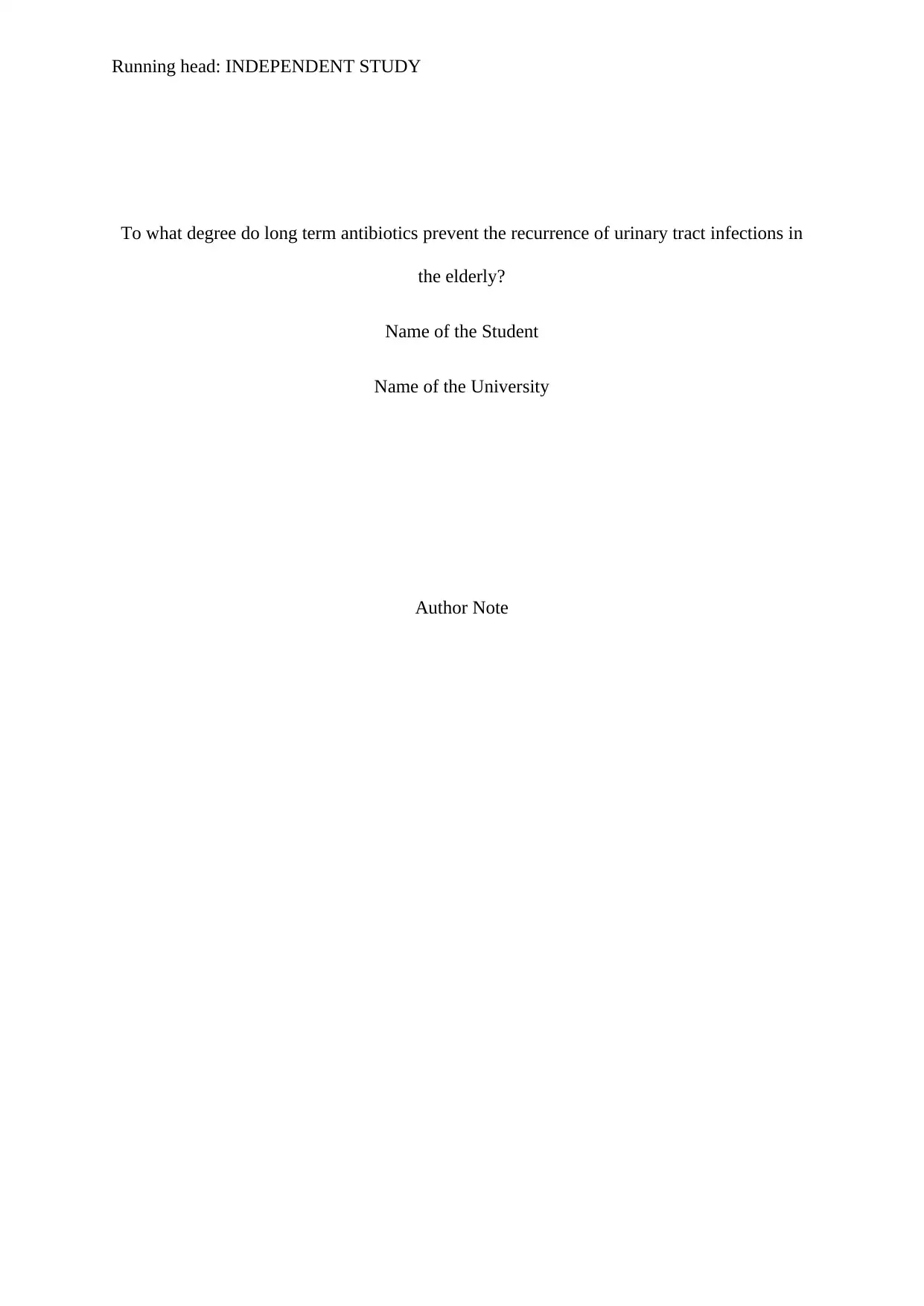
Running head: INDEPENDENT STUDY
To what degree do long term antibiotics prevent the recurrence of urinary tract infections in
the elderly?
Name of the Student
Name of the University
Author Note
To what degree do long term antibiotics prevent the recurrence of urinary tract infections in
the elderly?
Name of the Student
Name of the University
Author Note
Paraphrase This Document
Need a fresh take? Get an instant paraphrase of this document with our AI Paraphraser
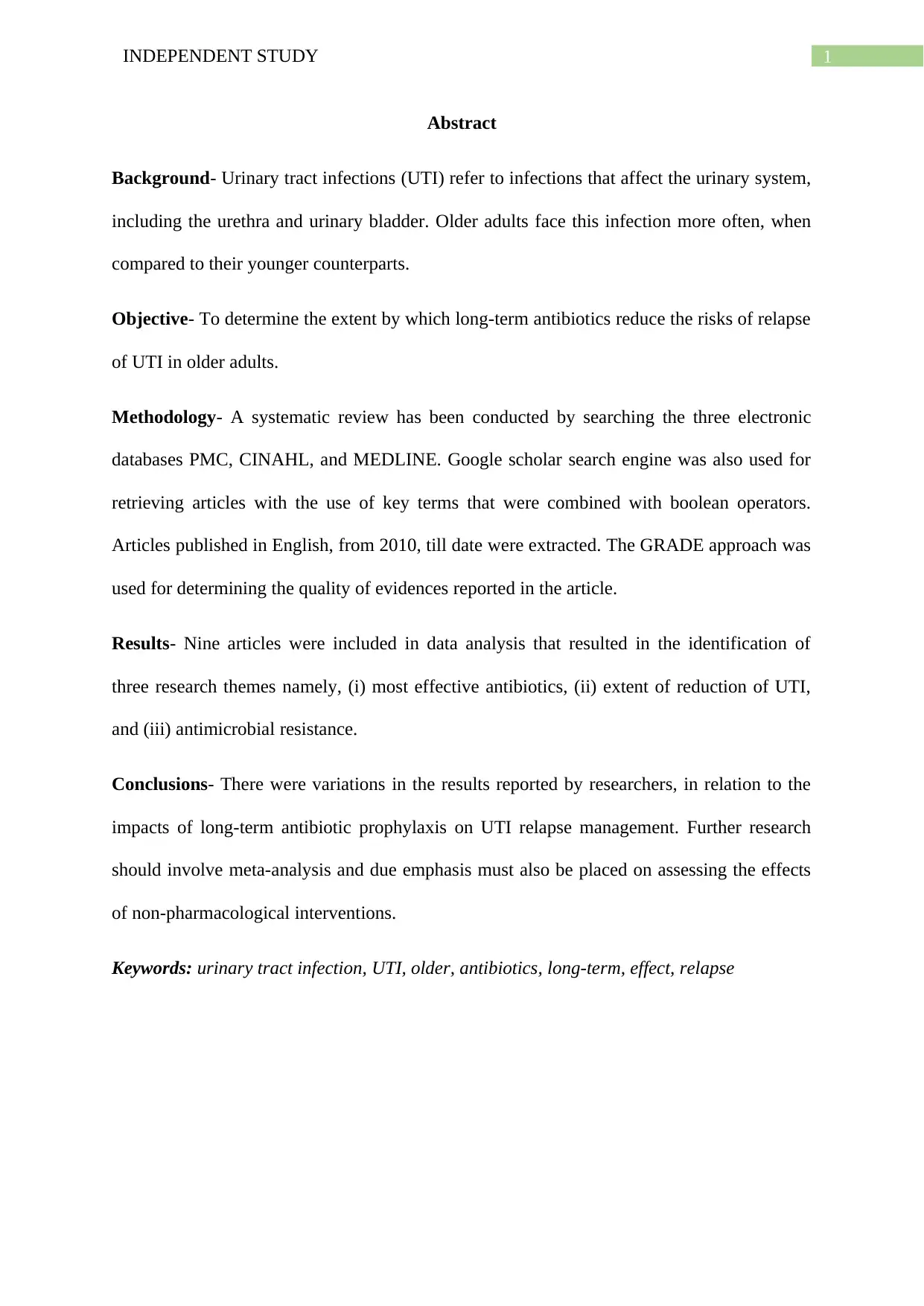
1INDEPENDENT STUDY
Abstract
Background- Urinary tract infections (UTI) refer to infections that affect the urinary system,
including the urethra and urinary bladder. Older adults face this infection more often, when
compared to their younger counterparts.
Objective- To determine the extent by which long-term antibiotics reduce the risks of relapse
of UTI in older adults.
Methodology- A systematic review has been conducted by searching the three electronic
databases PMC, CINAHL, and MEDLINE. Google scholar search engine was also used for
retrieving articles with the use of key terms that were combined with boolean operators.
Articles published in English, from 2010, till date were extracted. The GRADE approach was
used for determining the quality of evidences reported in the article.
Results- Nine articles were included in data analysis that resulted in the identification of
three research themes namely, (i) most effective antibiotics, (ii) extent of reduction of UTI,
and (iii) antimicrobial resistance.
Conclusions- There were variations in the results reported by researchers, in relation to the
impacts of long-term antibiotic prophylaxis on UTI relapse management. Further research
should involve meta-analysis and due emphasis must also be placed on assessing the effects
of non-pharmacological interventions.
Keywords: urinary tract infection, UTI, older, antibiotics, long-term, effect, relapse
Abstract
Background- Urinary tract infections (UTI) refer to infections that affect the urinary system,
including the urethra and urinary bladder. Older adults face this infection more often, when
compared to their younger counterparts.
Objective- To determine the extent by which long-term antibiotics reduce the risks of relapse
of UTI in older adults.
Methodology- A systematic review has been conducted by searching the three electronic
databases PMC, CINAHL, and MEDLINE. Google scholar search engine was also used for
retrieving articles with the use of key terms that were combined with boolean operators.
Articles published in English, from 2010, till date were extracted. The GRADE approach was
used for determining the quality of evidences reported in the article.
Results- Nine articles were included in data analysis that resulted in the identification of
three research themes namely, (i) most effective antibiotics, (ii) extent of reduction of UTI,
and (iii) antimicrobial resistance.
Conclusions- There were variations in the results reported by researchers, in relation to the
impacts of long-term antibiotic prophylaxis on UTI relapse management. Further research
should involve meta-analysis and due emphasis must also be placed on assessing the effects
of non-pharmacological interventions.
Keywords: urinary tract infection, UTI, older, antibiotics, long-term, effect, relapse
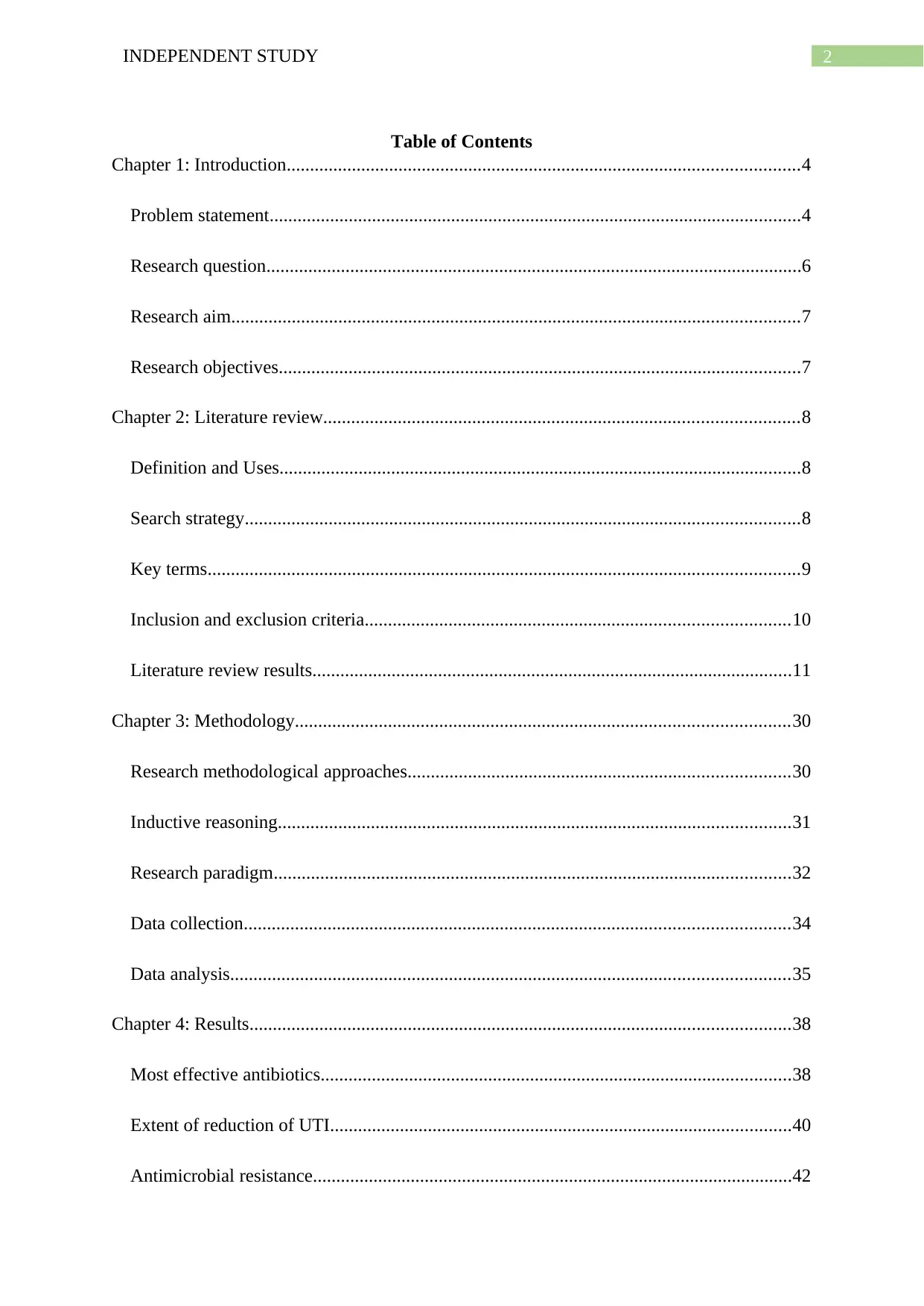
2INDEPENDENT STUDY
Table of Contents
Chapter 1: Introduction..............................................................................................................4
Problem statement..................................................................................................................4
Research question...................................................................................................................6
Research aim..........................................................................................................................7
Research objectives................................................................................................................7
Chapter 2: Literature review......................................................................................................8
Definition and Uses................................................................................................................8
Search strategy.......................................................................................................................8
Key terms...............................................................................................................................9
Inclusion and exclusion criteria...........................................................................................10
Literature review results.......................................................................................................11
Chapter 3: Methodology..........................................................................................................30
Research methodological approaches..................................................................................30
Inductive reasoning..............................................................................................................31
Research paradigm...............................................................................................................32
Data collection.....................................................................................................................34
Data analysis........................................................................................................................35
Chapter 4: Results....................................................................................................................38
Most effective antibiotics.....................................................................................................38
Extent of reduction of UTI...................................................................................................40
Antimicrobial resistance.......................................................................................................42
Table of Contents
Chapter 1: Introduction..............................................................................................................4
Problem statement..................................................................................................................4
Research question...................................................................................................................6
Research aim..........................................................................................................................7
Research objectives................................................................................................................7
Chapter 2: Literature review......................................................................................................8
Definition and Uses................................................................................................................8
Search strategy.......................................................................................................................8
Key terms...............................................................................................................................9
Inclusion and exclusion criteria...........................................................................................10
Literature review results.......................................................................................................11
Chapter 3: Methodology..........................................................................................................30
Research methodological approaches..................................................................................30
Inductive reasoning..............................................................................................................31
Research paradigm...............................................................................................................32
Data collection.....................................................................................................................34
Data analysis........................................................................................................................35
Chapter 4: Results....................................................................................................................38
Most effective antibiotics.....................................................................................................38
Extent of reduction of UTI...................................................................................................40
Antimicrobial resistance.......................................................................................................42
⊘ This is a preview!⊘
Do you want full access?
Subscribe today to unlock all pages.

Trusted by 1+ million students worldwide
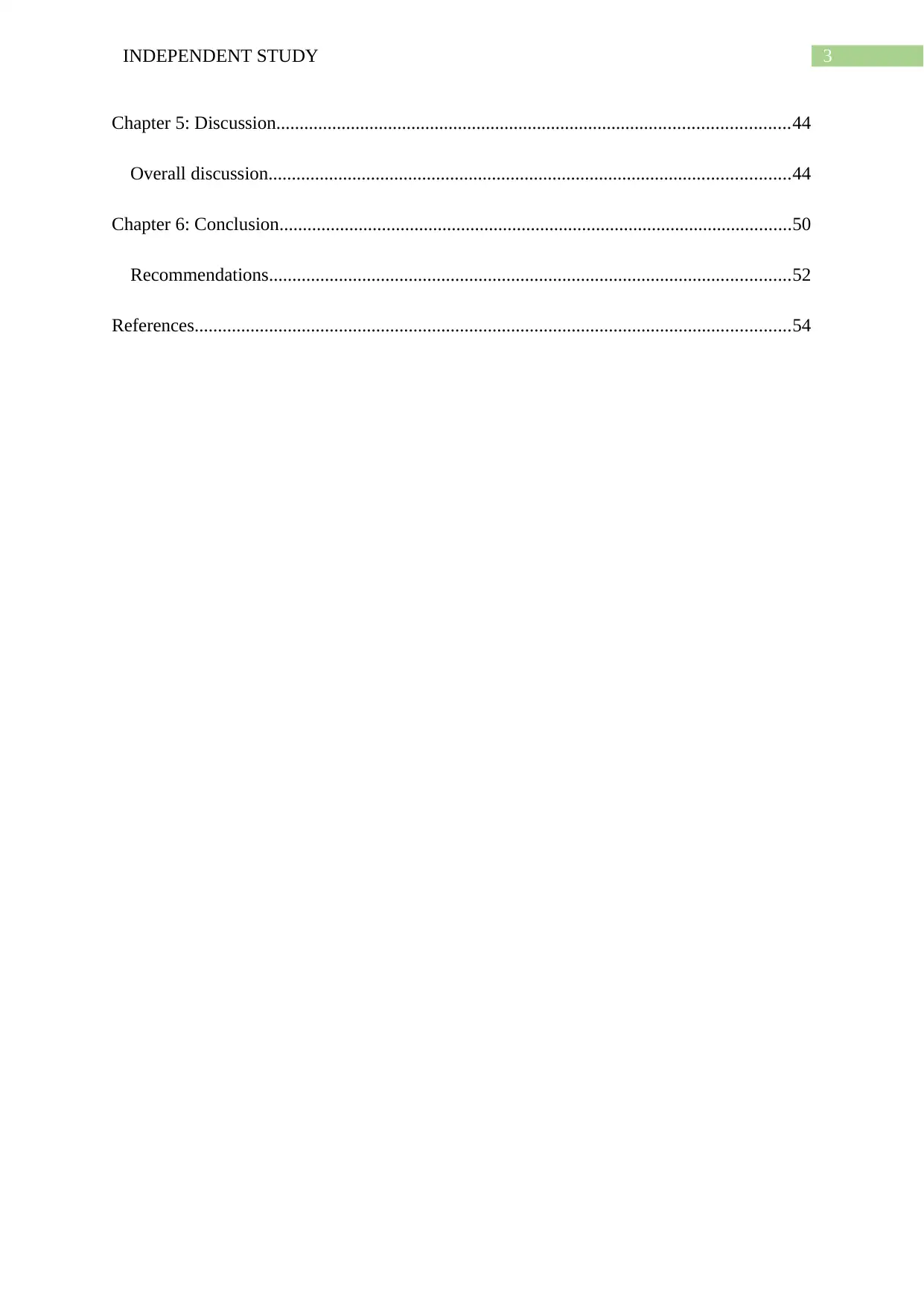
3INDEPENDENT STUDY
Chapter 5: Discussion..............................................................................................................44
Overall discussion................................................................................................................44
Chapter 6: Conclusion..............................................................................................................50
Recommendations................................................................................................................52
References................................................................................................................................54
Chapter 5: Discussion..............................................................................................................44
Overall discussion................................................................................................................44
Chapter 6: Conclusion..............................................................................................................50
Recommendations................................................................................................................52
References................................................................................................................................54
Paraphrase This Document
Need a fresh take? Get an instant paraphrase of this document with our AI Paraphraser
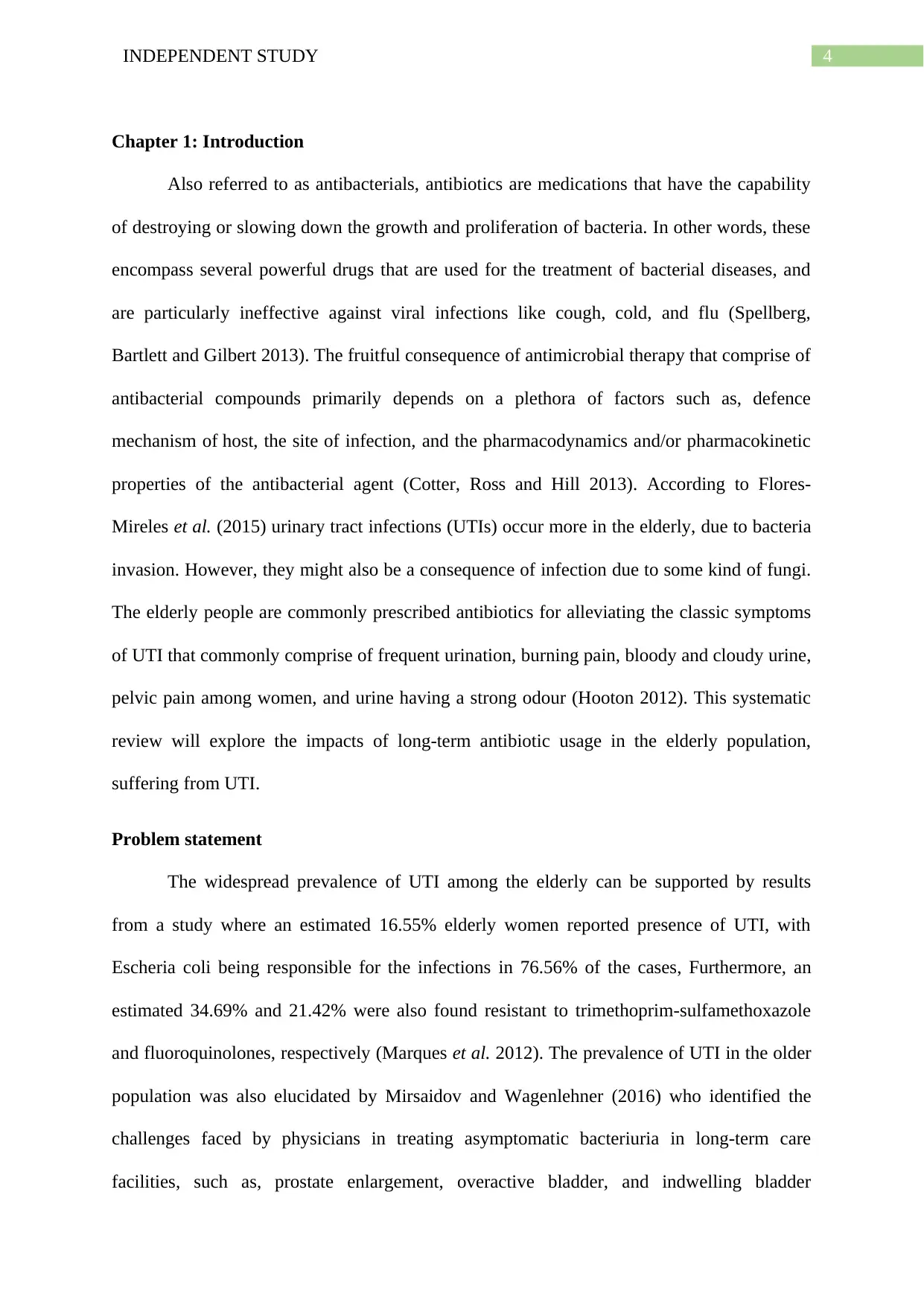
4INDEPENDENT STUDY
Chapter 1: Introduction
Also referred to as antibacterials, antibiotics are medications that have the capability
of destroying or slowing down the growth and proliferation of bacteria. In other words, these
encompass several powerful drugs that are used for the treatment of bacterial diseases, and
are particularly ineffective against viral infections like cough, cold, and flu (Spellberg,
Bartlett and Gilbert 2013). The fruitful consequence of antimicrobial therapy that comprise of
antibacterial compounds primarily depends on a plethora of factors such as, defence
mechanism of host, the site of infection, and the pharmacodynamics and/or pharmacokinetic
properties of the antibacterial agent (Cotter, Ross and Hill 2013). According to Flores-
Mireles et al. (2015) urinary tract infections (UTIs) occur more in the elderly, due to bacteria
invasion. However, they might also be a consequence of infection due to some kind of fungi.
The elderly people are commonly prescribed antibiotics for alleviating the classic symptoms
of UTI that commonly comprise of frequent urination, burning pain, bloody and cloudy urine,
pelvic pain among women, and urine having a strong odour (Hooton 2012). This systematic
review will explore the impacts of long-term antibiotic usage in the elderly population,
suffering from UTI.
Problem statement
The widespread prevalence of UTI among the elderly can be supported by results
from a study where an estimated 16.55% elderly women reported presence of UTI, with
Escheria coli being responsible for the infections in 76.56% of the cases, Furthermore, an
estimated 34.69% and 21.42% were also found resistant to trimethoprim-sulfamethoxazole
and fluoroquinolones, respectively (Marques et al. 2012). The prevalence of UTI in the older
population was also elucidated by Mirsaidov and Wagenlehner (2016) who identified the
challenges faced by physicians in treating asymptomatic bacteriuria in long-term care
facilities, such as, prostate enlargement, overactive bladder, and indwelling bladder
Chapter 1: Introduction
Also referred to as antibacterials, antibiotics are medications that have the capability
of destroying or slowing down the growth and proliferation of bacteria. In other words, these
encompass several powerful drugs that are used for the treatment of bacterial diseases, and
are particularly ineffective against viral infections like cough, cold, and flu (Spellberg,
Bartlett and Gilbert 2013). The fruitful consequence of antimicrobial therapy that comprise of
antibacterial compounds primarily depends on a plethora of factors such as, defence
mechanism of host, the site of infection, and the pharmacodynamics and/or pharmacokinetic
properties of the antibacterial agent (Cotter, Ross and Hill 2013). According to Flores-
Mireles et al. (2015) urinary tract infections (UTIs) occur more in the elderly, due to bacteria
invasion. However, they might also be a consequence of infection due to some kind of fungi.
The elderly people are commonly prescribed antibiotics for alleviating the classic symptoms
of UTI that commonly comprise of frequent urination, burning pain, bloody and cloudy urine,
pelvic pain among women, and urine having a strong odour (Hooton 2012). This systematic
review will explore the impacts of long-term antibiotic usage in the elderly population,
suffering from UTI.
Problem statement
The widespread prevalence of UTI among the elderly can be supported by results
from a study where an estimated 16.55% elderly women reported presence of UTI, with
Escheria coli being responsible for the infections in 76.56% of the cases, Furthermore, an
estimated 34.69% and 21.42% were also found resistant to trimethoprim-sulfamethoxazole
and fluoroquinolones, respectively (Marques et al. 2012). The prevalence of UTI in the older
population was also elucidated by Mirsaidov and Wagenlehner (2016) who identified the
challenges faced by physicians in treating asymptomatic bacteriuria in long-term care
facilities, such as, prostate enlargement, overactive bladder, and indwelling bladder
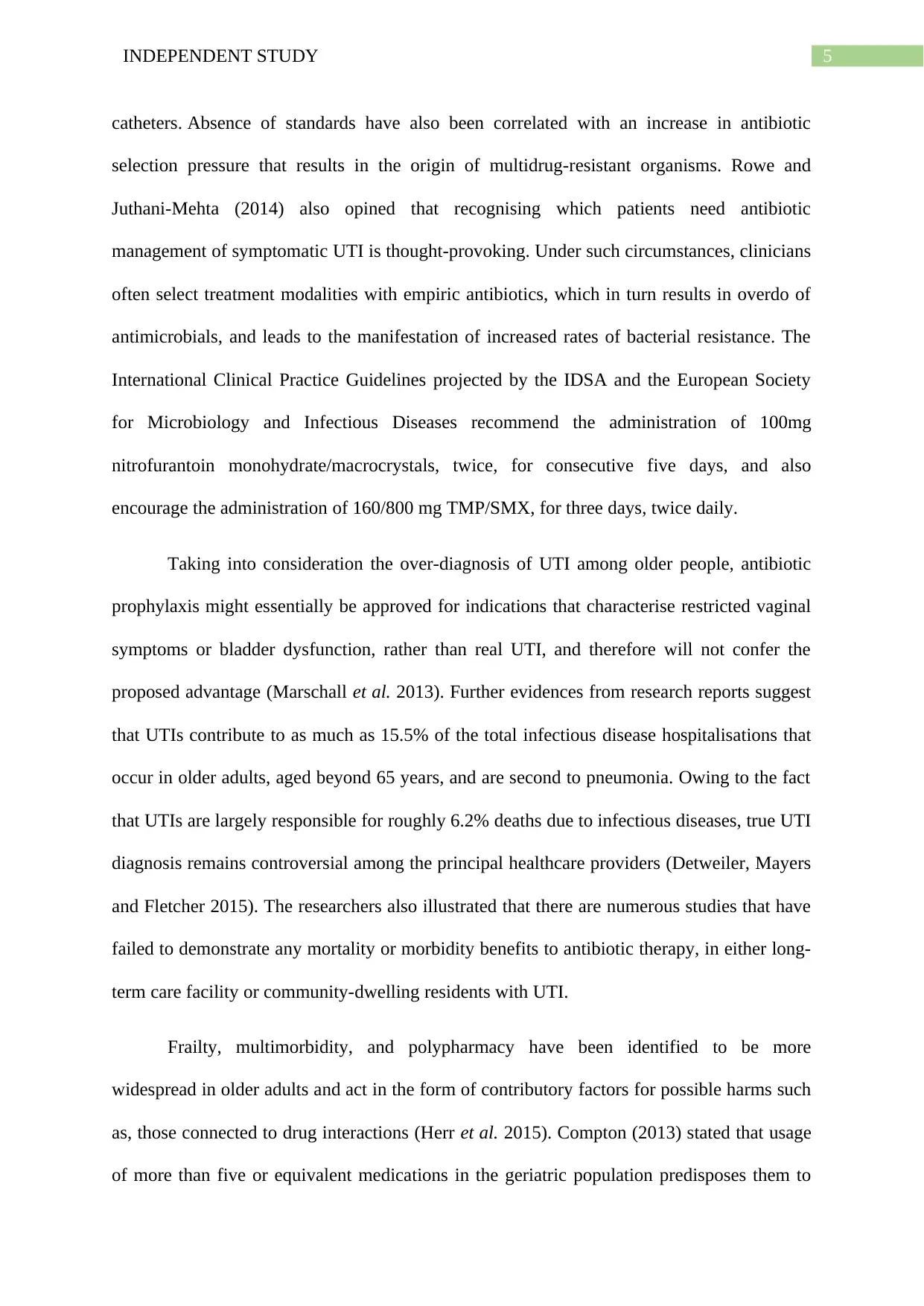
5INDEPENDENT STUDY
catheters. Absence of standards have also been correlated with an increase in antibiotic
selection pressure that results in the origin of multidrug-resistant organisms. Rowe and
Juthani-Mehta (2014) also opined that recognising which patients need antibiotic
management of symptomatic UTI is thought-provoking. Under such circumstances, clinicians
often select treatment modalities with empiric antibiotics, which in turn results in overdo of
antimicrobials, and leads to the manifestation of increased rates of bacterial resistance. The
International Clinical Practice Guidelines projected by the IDSA and the European Society
for Microbiology and Infectious Diseases recommend the administration of 100mg
nitrofurantoin monohydrate/macrocrystals, twice, for consecutive five days, and also
encourage the administration of 160/800 mg TMP/SMX, for three days, twice daily.
Taking into consideration the over-diagnosis of UTI among older people, antibiotic
prophylaxis might essentially be approved for indications that characterise restricted vaginal
symptoms or bladder dysfunction, rather than real UTI, and therefore will not confer the
proposed advantage (Marschall et al. 2013). Further evidences from research reports suggest
that UTIs contribute to as much as 15.5% of the total infectious disease hospitalisations that
occur in older adults, aged beyond 65 years, and are second to pneumonia. Owing to the fact
that UTIs are largely responsible for roughly 6.2% deaths due to infectious diseases, true UTI
diagnosis remains controversial among the principal healthcare providers (Detweiler, Mayers
and Fletcher 2015). The researchers also illustrated that there are numerous studies that have
failed to demonstrate any mortality or morbidity benefits to antibiotic therapy, in either long-
term care facility or community-dwelling residents with UTI.
Frailty, multimorbidity, and polypharmacy have been identified to be more
widespread in older adults and act in the form of contributory factors for possible harms such
as, those connected to drug interactions (Herr et al. 2015). Compton (2013) stated that usage
of more than five or equivalent medications in the geriatric population predisposes them to
catheters. Absence of standards have also been correlated with an increase in antibiotic
selection pressure that results in the origin of multidrug-resistant organisms. Rowe and
Juthani-Mehta (2014) also opined that recognising which patients need antibiotic
management of symptomatic UTI is thought-provoking. Under such circumstances, clinicians
often select treatment modalities with empiric antibiotics, which in turn results in overdo of
antimicrobials, and leads to the manifestation of increased rates of bacterial resistance. The
International Clinical Practice Guidelines projected by the IDSA and the European Society
for Microbiology and Infectious Diseases recommend the administration of 100mg
nitrofurantoin monohydrate/macrocrystals, twice, for consecutive five days, and also
encourage the administration of 160/800 mg TMP/SMX, for three days, twice daily.
Taking into consideration the over-diagnosis of UTI among older people, antibiotic
prophylaxis might essentially be approved for indications that characterise restricted vaginal
symptoms or bladder dysfunction, rather than real UTI, and therefore will not confer the
proposed advantage (Marschall et al. 2013). Further evidences from research reports suggest
that UTIs contribute to as much as 15.5% of the total infectious disease hospitalisations that
occur in older adults, aged beyond 65 years, and are second to pneumonia. Owing to the fact
that UTIs are largely responsible for roughly 6.2% deaths due to infectious diseases, true UTI
diagnosis remains controversial among the principal healthcare providers (Detweiler, Mayers
and Fletcher 2015). The researchers also illustrated that there are numerous studies that have
failed to demonstrate any mortality or morbidity benefits to antibiotic therapy, in either long-
term care facility or community-dwelling residents with UTI.
Frailty, multimorbidity, and polypharmacy have been identified to be more
widespread in older adults and act in the form of contributory factors for possible harms such
as, those connected to drug interactions (Herr et al. 2015). Compton (2013) stated that usage
of more than five or equivalent medications in the geriatric population predisposes them to
⊘ This is a preview!⊘
Do you want full access?
Subscribe today to unlock all pages.

Trusted by 1+ million students worldwide
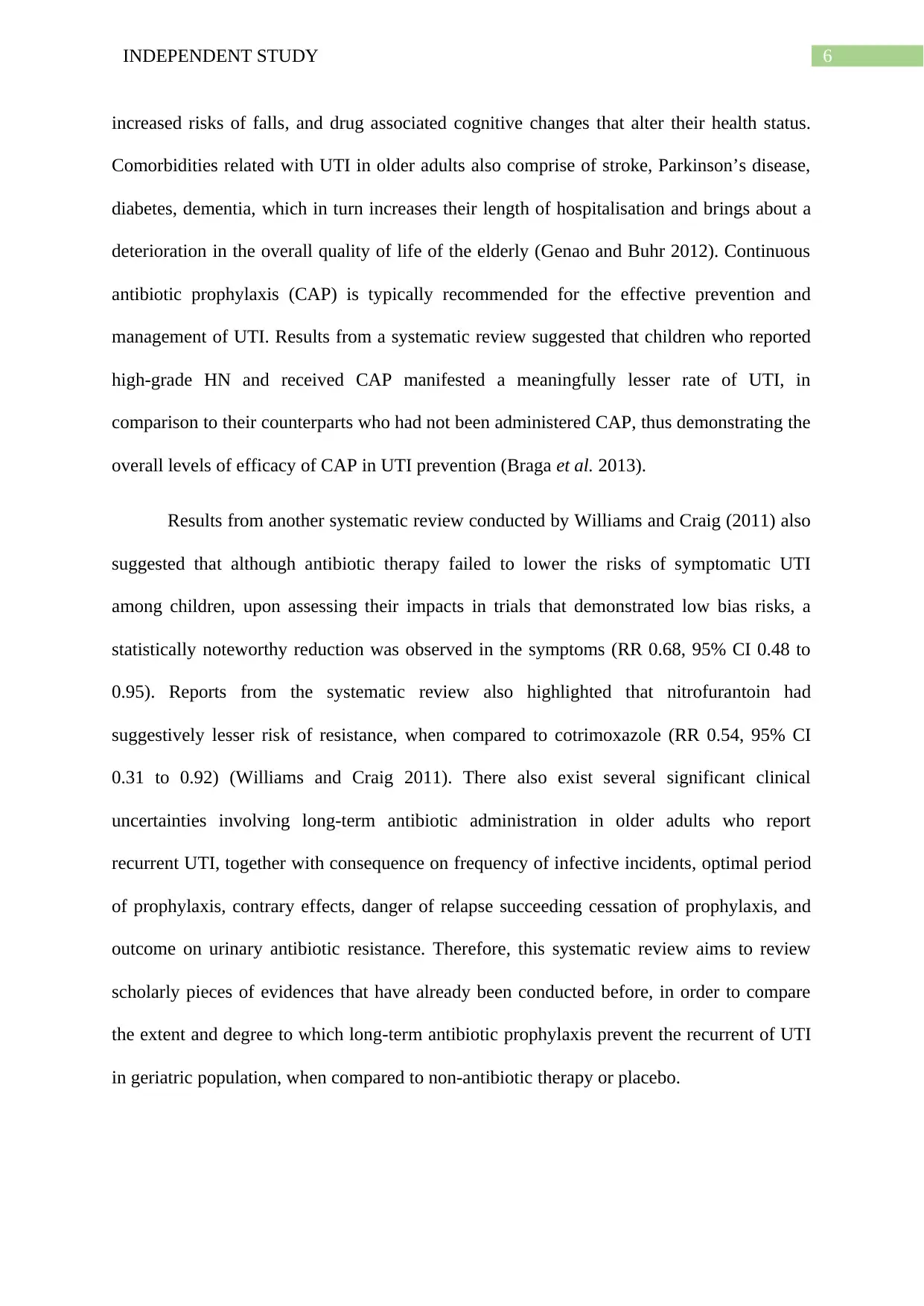
6INDEPENDENT STUDY
increased risks of falls, and drug associated cognitive changes that alter their health status.
Comorbidities related with UTI in older adults also comprise of stroke, Parkinson’s disease,
diabetes, dementia, which in turn increases their length of hospitalisation and brings about a
deterioration in the overall quality of life of the elderly (Genao and Buhr 2012). Continuous
antibiotic prophylaxis (CAP) is typically recommended for the effective prevention and
management of UTI. Results from a systematic review suggested that children who reported
high-grade HN and received CAP manifested a meaningfully lesser rate of UTI, in
comparison to their counterparts who had not been administered CAP, thus demonstrating the
overall levels of efficacy of CAP in UTI prevention (Braga et al. 2013).
Results from another systematic review conducted by Williams and Craig (2011) also
suggested that although antibiotic therapy failed to lower the risks of symptomatic UTI
among children, upon assessing their impacts in trials that demonstrated low bias risks, a
statistically noteworthy reduction was observed in the symptoms (RR 0.68, 95% CI 0.48 to
0.95). Reports from the systematic review also highlighted that nitrofurantoin had
suggestively lesser risk of resistance, when compared to cotrimoxazole (RR 0.54, 95% CI
0.31 to 0.92) (Williams and Craig 2011). There also exist several significant clinical
uncertainties involving long-term antibiotic administration in older adults who report
recurrent UTI, together with consequence on frequency of infective incidents, optimal period
of prophylaxis, contrary effects, danger of relapse succeeding cessation of prophylaxis, and
outcome on urinary antibiotic resistance. Therefore, this systematic review aims to review
scholarly pieces of evidences that have already been conducted before, in order to compare
the extent and degree to which long-term antibiotic prophylaxis prevent the recurrent of UTI
in geriatric population, when compared to non-antibiotic therapy or placebo.
increased risks of falls, and drug associated cognitive changes that alter their health status.
Comorbidities related with UTI in older adults also comprise of stroke, Parkinson’s disease,
diabetes, dementia, which in turn increases their length of hospitalisation and brings about a
deterioration in the overall quality of life of the elderly (Genao and Buhr 2012). Continuous
antibiotic prophylaxis (CAP) is typically recommended for the effective prevention and
management of UTI. Results from a systematic review suggested that children who reported
high-grade HN and received CAP manifested a meaningfully lesser rate of UTI, in
comparison to their counterparts who had not been administered CAP, thus demonstrating the
overall levels of efficacy of CAP in UTI prevention (Braga et al. 2013).
Results from another systematic review conducted by Williams and Craig (2011) also
suggested that although antibiotic therapy failed to lower the risks of symptomatic UTI
among children, upon assessing their impacts in trials that demonstrated low bias risks, a
statistically noteworthy reduction was observed in the symptoms (RR 0.68, 95% CI 0.48 to
0.95). Reports from the systematic review also highlighted that nitrofurantoin had
suggestively lesser risk of resistance, when compared to cotrimoxazole (RR 0.54, 95% CI
0.31 to 0.92) (Williams and Craig 2011). There also exist several significant clinical
uncertainties involving long-term antibiotic administration in older adults who report
recurrent UTI, together with consequence on frequency of infective incidents, optimal period
of prophylaxis, contrary effects, danger of relapse succeeding cessation of prophylaxis, and
outcome on urinary antibiotic resistance. Therefore, this systematic review aims to review
scholarly pieces of evidences that have already been conducted before, in order to compare
the extent and degree to which long-term antibiotic prophylaxis prevent the recurrent of UTI
in geriatric population, when compared to non-antibiotic therapy or placebo.
Paraphrase This Document
Need a fresh take? Get an instant paraphrase of this document with our AI Paraphraser
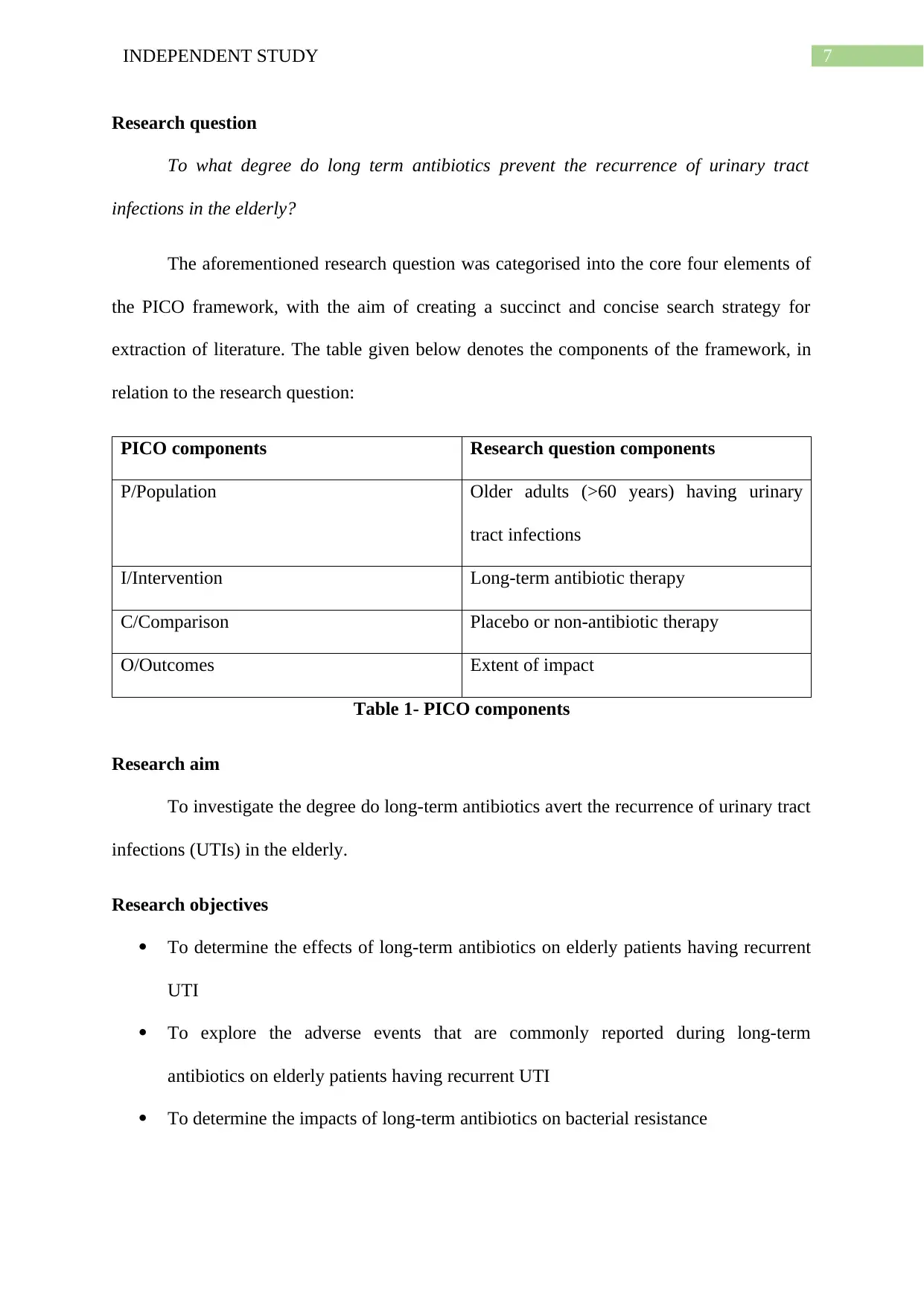
7INDEPENDENT STUDY
Research question
To what degree do long term antibiotics prevent the recurrence of urinary tract
infections in the elderly?
The aforementioned research question was categorised into the core four elements of
the PICO framework, with the aim of creating a succinct and concise search strategy for
extraction of literature. The table given below denotes the components of the framework, in
relation to the research question:
PICO components Research question components
P/Population Older adults (>60 years) having urinary
tract infections
I/Intervention Long-term antibiotic therapy
C/Comparison Placebo or non-antibiotic therapy
O/Outcomes Extent of impact
Table 1- PICO components
Research aim
To investigate the degree do long-term antibiotics avert the recurrence of urinary tract
infections (UTIs) in the elderly.
Research objectives
To determine the effects of long-term antibiotics on elderly patients having recurrent
UTI
To explore the adverse events that are commonly reported during long-term
antibiotics on elderly patients having recurrent UTI
To determine the impacts of long-term antibiotics on bacterial resistance
Research question
To what degree do long term antibiotics prevent the recurrence of urinary tract
infections in the elderly?
The aforementioned research question was categorised into the core four elements of
the PICO framework, with the aim of creating a succinct and concise search strategy for
extraction of literature. The table given below denotes the components of the framework, in
relation to the research question:
PICO components Research question components
P/Population Older adults (>60 years) having urinary
tract infections
I/Intervention Long-term antibiotic therapy
C/Comparison Placebo or non-antibiotic therapy
O/Outcomes Extent of impact
Table 1- PICO components
Research aim
To investigate the degree do long-term antibiotics avert the recurrence of urinary tract
infections (UTIs) in the elderly.
Research objectives
To determine the effects of long-term antibiotics on elderly patients having recurrent
UTI
To explore the adverse events that are commonly reported during long-term
antibiotics on elderly patients having recurrent UTI
To determine the impacts of long-term antibiotics on bacterial resistance
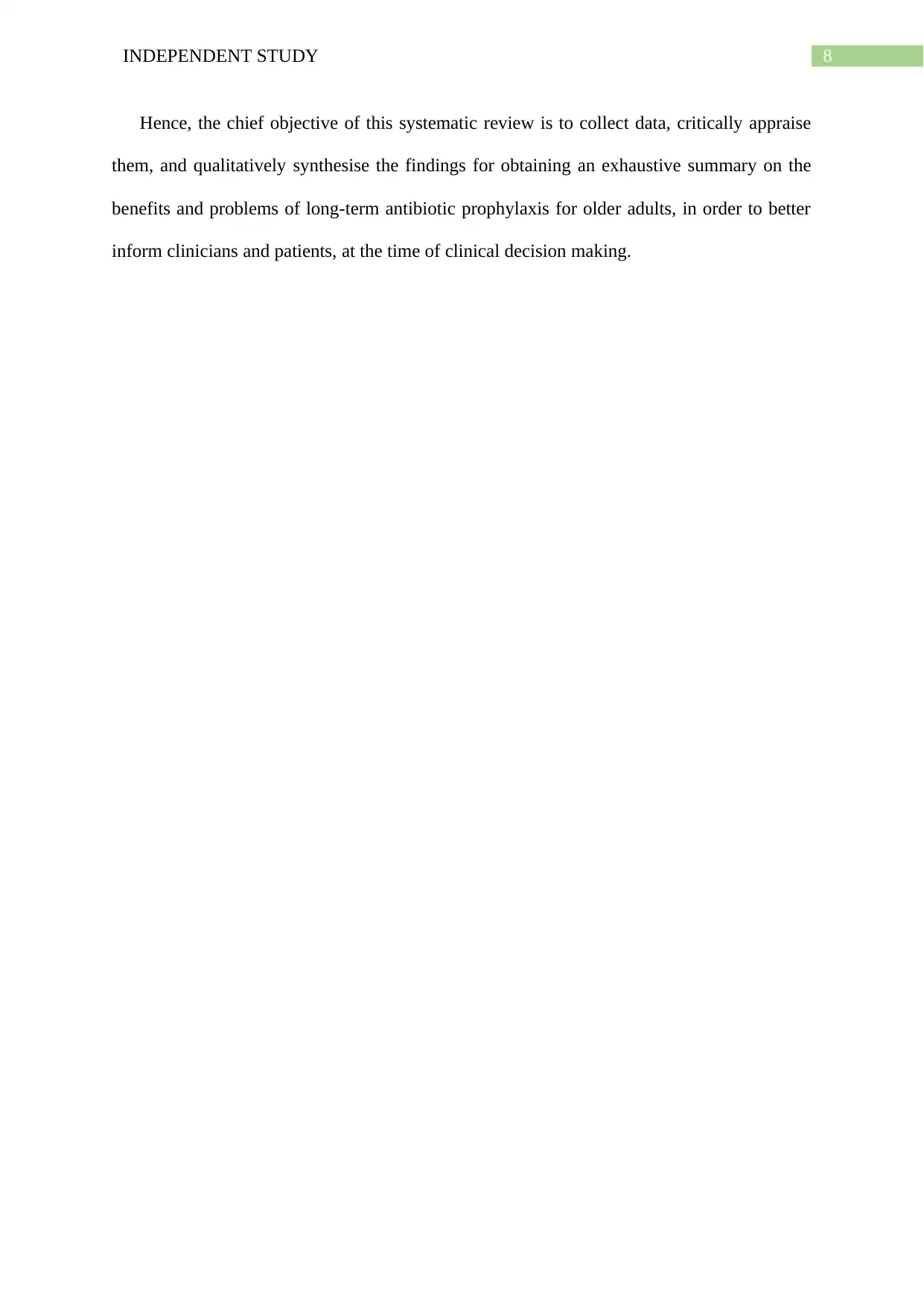
8INDEPENDENT STUDY
Hence, the chief objective of this systematic review is to collect data, critically appraise
them, and qualitatively synthesise the findings for obtaining an exhaustive summary on the
benefits and problems of long-term antibiotic prophylaxis for older adults, in order to better
inform clinicians and patients, at the time of clinical decision making.
Hence, the chief objective of this systematic review is to collect data, critically appraise
them, and qualitatively synthesise the findings for obtaining an exhaustive summary on the
benefits and problems of long-term antibiotic prophylaxis for older adults, in order to better
inform clinicians and patients, at the time of clinical decision making.
⊘ This is a preview!⊘
Do you want full access?
Subscribe today to unlock all pages.

Trusted by 1+ million students worldwide
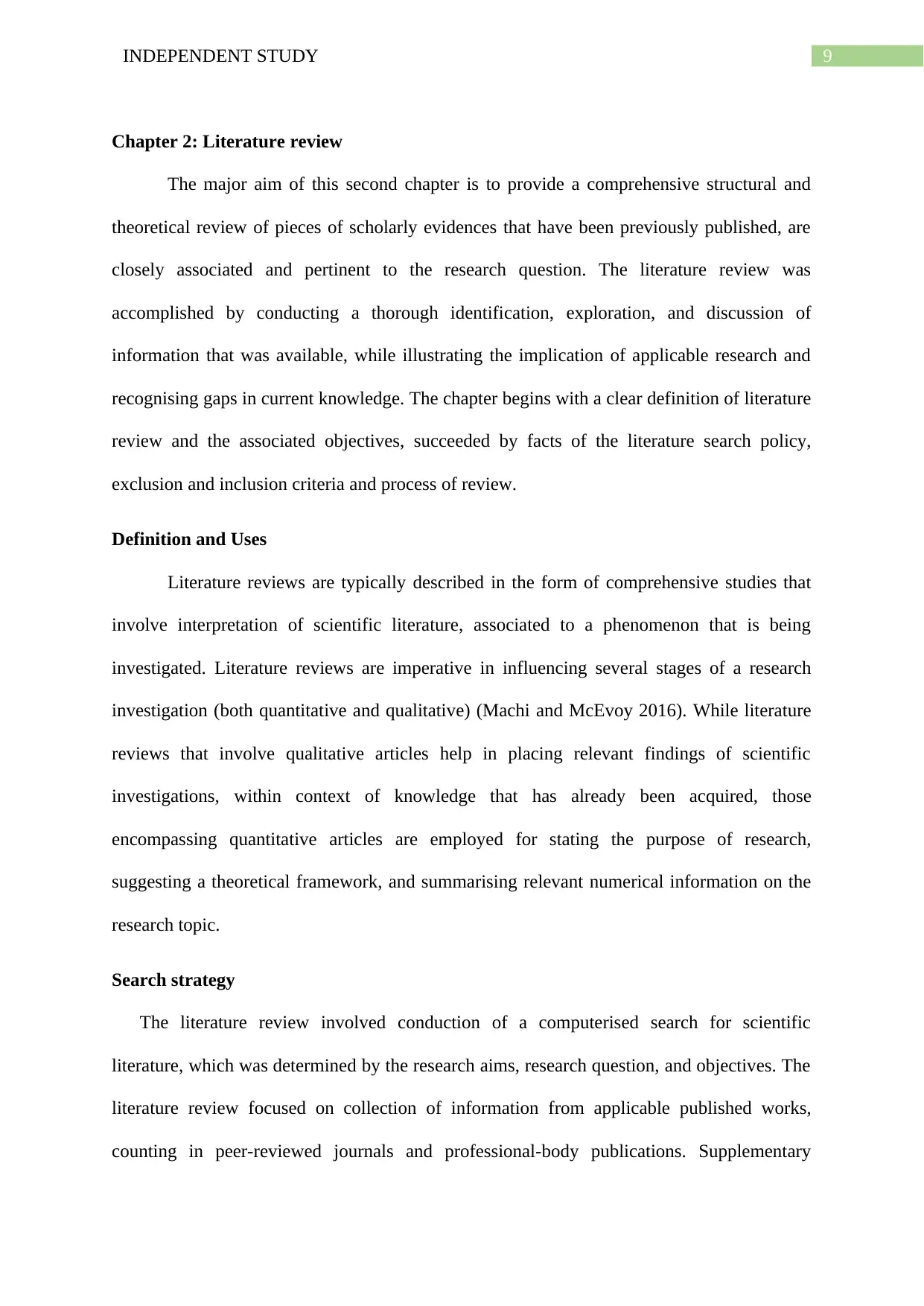
9INDEPENDENT STUDY
Chapter 2: Literature review
The major aim of this second chapter is to provide a comprehensive structural and
theoretical review of pieces of scholarly evidences that have been previously published, are
closely associated and pertinent to the research question. The literature review was
accomplished by conducting a thorough identification, exploration, and discussion of
information that was available, while illustrating the implication of applicable research and
recognising gaps in current knowledge. The chapter begins with a clear definition of literature
review and the associated objectives, succeeded by facts of the literature search policy,
exclusion and inclusion criteria and process of review.
Definition and Uses
Literature reviews are typically described in the form of comprehensive studies that
involve interpretation of scientific literature, associated to a phenomenon that is being
investigated. Literature reviews are imperative in influencing several stages of a research
investigation (both quantitative and qualitative) (Machi and McEvoy 2016). While literature
reviews that involve qualitative articles help in placing relevant findings of scientific
investigations, within context of knowledge that has already been acquired, those
encompassing quantitative articles are employed for stating the purpose of research,
suggesting a theoretical framework, and summarising relevant numerical information on the
research topic.
Search strategy
The literature review involved conduction of a computerised search for scientific
literature, which was determined by the research aims, research question, and objectives. The
literature review focused on collection of information from applicable published works,
counting in peer-reviewed journals and professional-body publications. Supplementary
Chapter 2: Literature review
The major aim of this second chapter is to provide a comprehensive structural and
theoretical review of pieces of scholarly evidences that have been previously published, are
closely associated and pertinent to the research question. The literature review was
accomplished by conducting a thorough identification, exploration, and discussion of
information that was available, while illustrating the implication of applicable research and
recognising gaps in current knowledge. The chapter begins with a clear definition of literature
review and the associated objectives, succeeded by facts of the literature search policy,
exclusion and inclusion criteria and process of review.
Definition and Uses
Literature reviews are typically described in the form of comprehensive studies that
involve interpretation of scientific literature, associated to a phenomenon that is being
investigated. Literature reviews are imperative in influencing several stages of a research
investigation (both quantitative and qualitative) (Machi and McEvoy 2016). While literature
reviews that involve qualitative articles help in placing relevant findings of scientific
investigations, within context of knowledge that has already been acquired, those
encompassing quantitative articles are employed for stating the purpose of research,
suggesting a theoretical framework, and summarising relevant numerical information on the
research topic.
Search strategy
The literature review involved conduction of a computerised search for scientific
literature, which was determined by the research aims, research question, and objectives. The
literature review focused on collection of information from applicable published works,
counting in peer-reviewed journals and professional-body publications. Supplementary
Paraphrase This Document
Need a fresh take? Get an instant paraphrase of this document with our AI Paraphraser
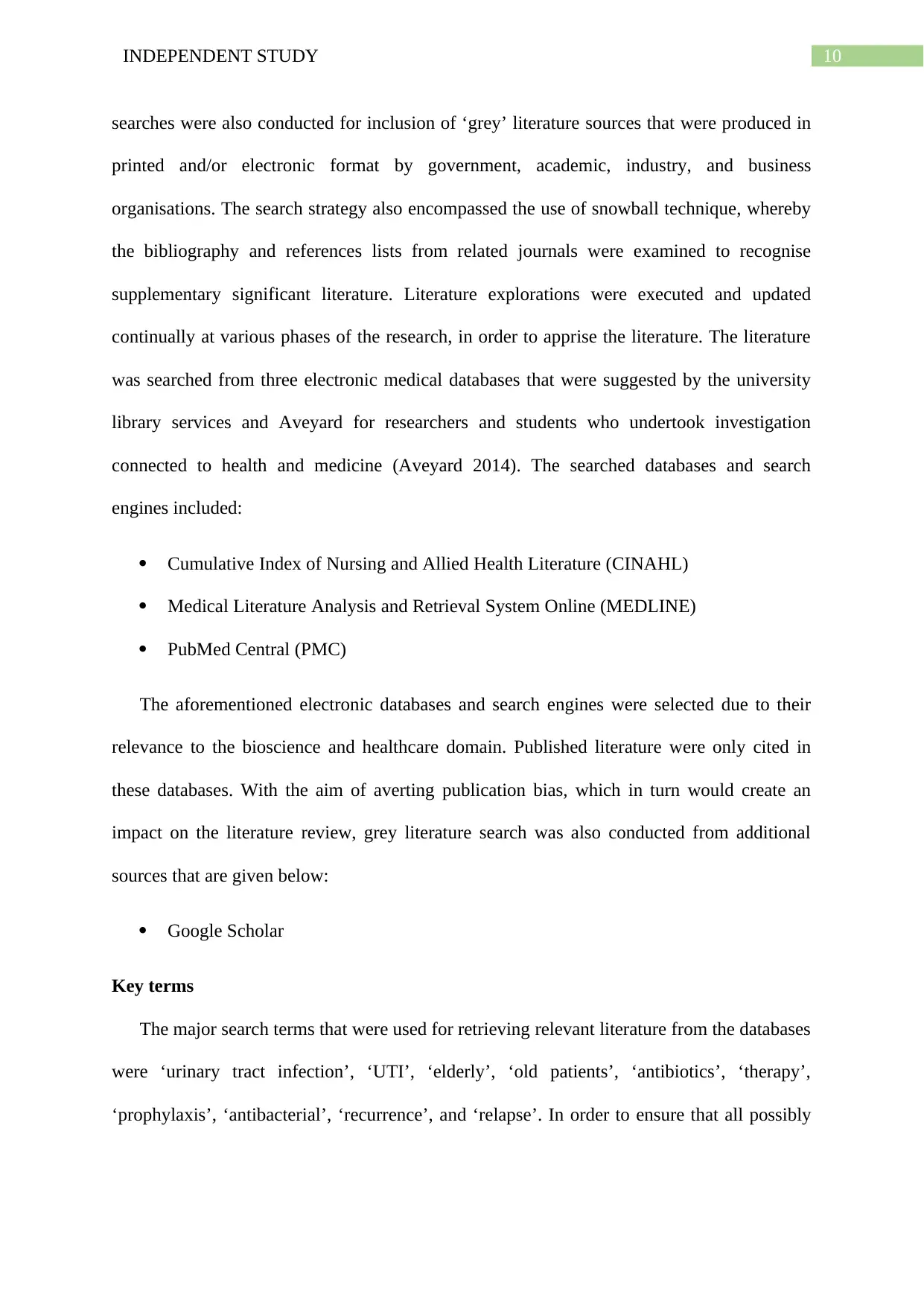
10INDEPENDENT STUDY
searches were also conducted for inclusion of ‘grey’ literature sources that were produced in
printed and/or electronic format by government, academic, industry, and business
organisations. The search strategy also encompassed the use of snowball technique, whereby
the bibliography and references lists from related journals were examined to recognise
supplementary significant literature. Literature explorations were executed and updated
continually at various phases of the research, in order to apprise the literature. The literature
was searched from three electronic medical databases that were suggested by the university
library services and Aveyard for researchers and students who undertook investigation
connected to health and medicine (Aveyard 2014). The searched databases and search
engines included:
Cumulative Index of Nursing and Allied Health Literature (CINAHL)
Medical Literature Analysis and Retrieval System Online (MEDLINE)
PubMed Central (PMC)
The aforementioned electronic databases and search engines were selected due to their
relevance to the bioscience and healthcare domain. Published literature were only cited in
these databases. With the aim of averting publication bias, which in turn would create an
impact on the literature review, grey literature search was also conducted from additional
sources that are given below:
Google Scholar
Key terms
The major search terms that were used for retrieving relevant literature from the databases
were ‘urinary tract infection’, ‘UTI’, ‘elderly’, ‘old patients’, ‘antibiotics’, ‘therapy’,
‘prophylaxis’, ‘antibacterial’, ‘recurrence’, and ‘relapse’. In order to ensure that all possibly
searches were also conducted for inclusion of ‘grey’ literature sources that were produced in
printed and/or electronic format by government, academic, industry, and business
organisations. The search strategy also encompassed the use of snowball technique, whereby
the bibliography and references lists from related journals were examined to recognise
supplementary significant literature. Literature explorations were executed and updated
continually at various phases of the research, in order to apprise the literature. The literature
was searched from three electronic medical databases that were suggested by the university
library services and Aveyard for researchers and students who undertook investigation
connected to health and medicine (Aveyard 2014). The searched databases and search
engines included:
Cumulative Index of Nursing and Allied Health Literature (CINAHL)
Medical Literature Analysis and Retrieval System Online (MEDLINE)
PubMed Central (PMC)
The aforementioned electronic databases and search engines were selected due to their
relevance to the bioscience and healthcare domain. Published literature were only cited in
these databases. With the aim of averting publication bias, which in turn would create an
impact on the literature review, grey literature search was also conducted from additional
sources that are given below:
Google Scholar
Key terms
The major search terms that were used for retrieving relevant literature from the databases
were ‘urinary tract infection’, ‘UTI’, ‘elderly’, ‘old patients’, ‘antibiotics’, ‘therapy’,
‘prophylaxis’, ‘antibacterial’, ‘recurrence’, and ‘relapse’. In order to ensure that all possibly
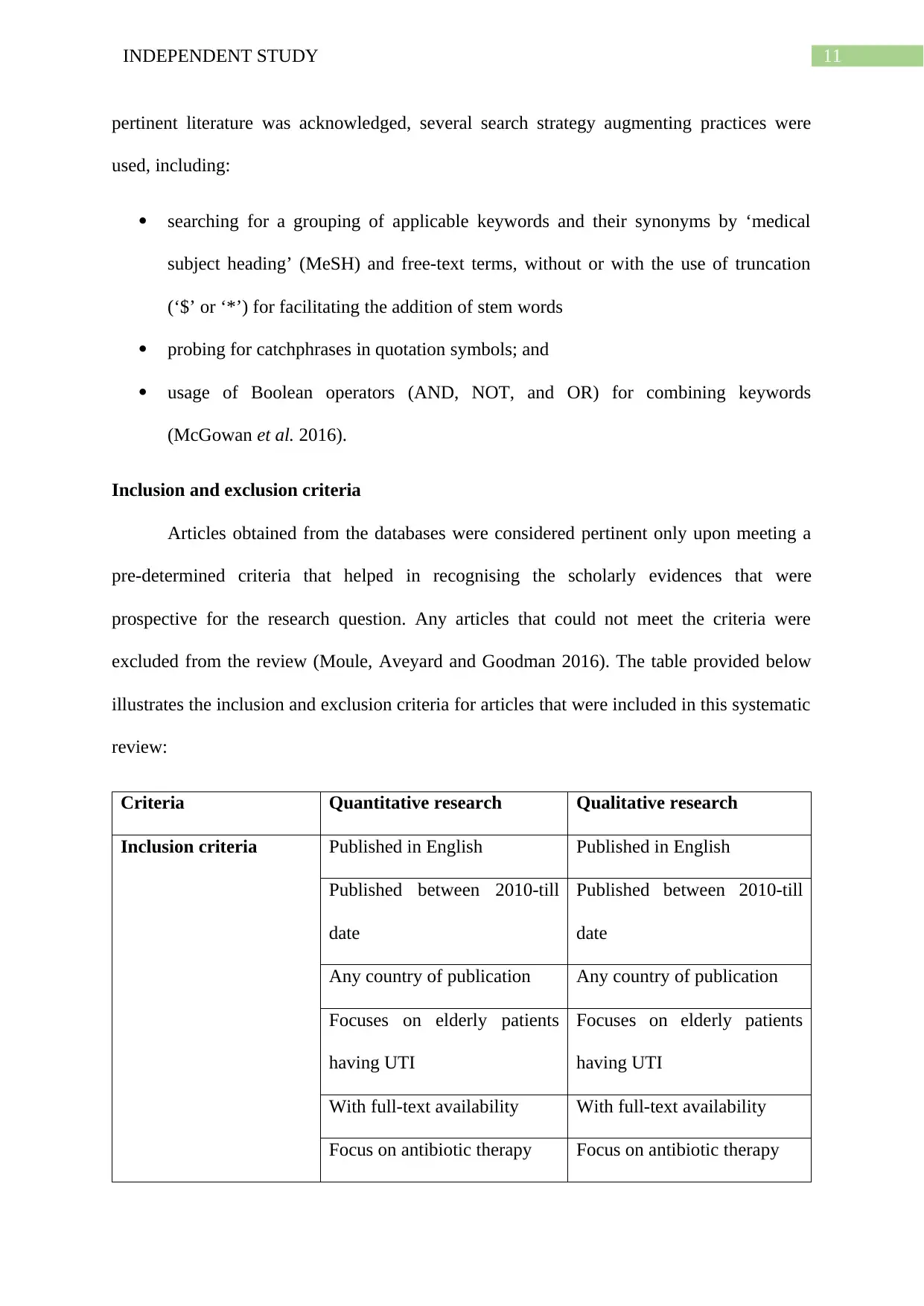
11INDEPENDENT STUDY
pertinent literature was acknowledged, several search strategy augmenting practices were
used, including:
searching for a grouping of applicable keywords and their synonyms by ‘medical
subject heading’ (MeSH) and free-text terms, without or with the use of truncation
(‘$’ or ‘*’) for facilitating the addition of stem words
probing for catchphrases in quotation symbols; and
usage of Boolean operators (AND, NOT, and OR) for combining keywords
(McGowan et al. 2016).
Inclusion and exclusion criteria
Articles obtained from the databases were considered pertinent only upon meeting a
pre-determined criteria that helped in recognising the scholarly evidences that were
prospective for the research question. Any articles that could not meet the criteria were
excluded from the review (Moule, Aveyard and Goodman 2016). The table provided below
illustrates the inclusion and exclusion criteria for articles that were included in this systematic
review:
Criteria Quantitative research Qualitative research
Inclusion criteria Published in English Published in English
Published between 2010-till
date
Published between 2010-till
date
Any country of publication Any country of publication
Focuses on elderly patients
having UTI
Focuses on elderly patients
having UTI
With full-text availability With full-text availability
Focus on antibiotic therapy Focus on antibiotic therapy
pertinent literature was acknowledged, several search strategy augmenting practices were
used, including:
searching for a grouping of applicable keywords and their synonyms by ‘medical
subject heading’ (MeSH) and free-text terms, without or with the use of truncation
(‘$’ or ‘*’) for facilitating the addition of stem words
probing for catchphrases in quotation symbols; and
usage of Boolean operators (AND, NOT, and OR) for combining keywords
(McGowan et al. 2016).
Inclusion and exclusion criteria
Articles obtained from the databases were considered pertinent only upon meeting a
pre-determined criteria that helped in recognising the scholarly evidences that were
prospective for the research question. Any articles that could not meet the criteria were
excluded from the review (Moule, Aveyard and Goodman 2016). The table provided below
illustrates the inclusion and exclusion criteria for articles that were included in this systematic
review:
Criteria Quantitative research Qualitative research
Inclusion criteria Published in English Published in English
Published between 2010-till
date
Published between 2010-till
date
Any country of publication Any country of publication
Focuses on elderly patients
having UTI
Focuses on elderly patients
having UTI
With full-text availability With full-text availability
Focus on antibiotic therapy Focus on antibiotic therapy
⊘ This is a preview!⊘
Do you want full access?
Subscribe today to unlock all pages.

Trusted by 1+ million students worldwide
1 out of 62
Related Documents
Your All-in-One AI-Powered Toolkit for Academic Success.
+13062052269
info@desklib.com
Available 24*7 on WhatsApp / Email
![[object Object]](/_next/static/media/star-bottom.7253800d.svg)
Unlock your academic potential
Copyright © 2020–2025 A2Z Services. All Rights Reserved. Developed and managed by ZUCOL.





